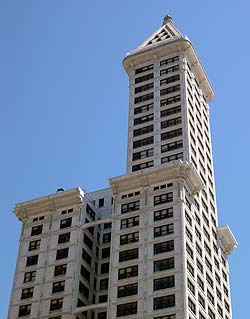I ventured to the top of the Columbia Tower, officially known as the Bank of America Tower, three years ago, for dinner before my senior prom. The limo pulled up in front of a massive skyscraper—76 stories, 937 feet of obsidianlike black glass, Seattle’s tallest structure—and two elevators later, we arrived at the Columbia Tower Club, which occupies the top two floors. Members of the club and their guests dine in style. The club has 360 degrees of windows, including the semifamous view from the women’s rest room. But what impressed me most were the after-dinner binoculars for watching the Mariners play in Safeco Field below. I was convinced that the Columbia Tower was the most incredible building around.
Three years later, I revisited the tallest building west of Chicago and north of Los Angeles so I could compare it to the Smith Tower, the Columbia Tower of 1914, which celebrated its 90th birthday this summer. The Smith Tower is a real contrast to today’s monolith. It’s white, it’s terra cotta, it’s architecturally dated.
But in 1914, the Smith Tower set standards in height and class. It was the city’s first skyscraper, towering above the low brick buildings of Pioneer Square. The lobby boasts carved marble walls, mahogany moldings, and the original information desk, still staffed by a uniformed assistant. The best features, however, are the smiling, uniformed elevator operators.
Lyman C. Smith, owner of the Smith-Corona typewriter company, wanted to expand his New York business to include a location in the still fledgling pioneer city of Seattle. Smith’s original plan was to build a simple 14-story office building. But after pressure from his son, he decided to build a tower that would make history—and hopefully help sell typewriters. Plans were laid for a 21-story building at 506 Second Ave., to be topped by a gothic tower of 21 more stories. Remarkably, the company Smith selected to design and build the tower had never built anything higher than a couple of stories.
The tower made history in 1914 as the tallest building outside New York and marked Seattle’s evolution from a little-known town to an up-and-coming big city. Despite renovation in 1999, including new wiring to serve the dot-com boom, the Smith Tower still boasts the charming early 1900s amenities that made it grand. There are no doors on the elevators, so visitors watch floors pass by through the brass cage, on the way up to the Chinese Room. Surrounded by a 360-degree observation deck, the room is the 1914 equivalent of the Tower Club. It was considered the best view in town and is decorated with carved wood furniture and handmade ceiling tiles, all gifts from the empress of China. The furniture includes a thronelike wishing chair, which, legend has it, guarantees marriage within a year for any single woman who sits in it. Smith’s daughter was wed in the Chinese Room a year after her visit to the building for opening festivities.
Owned and managed today by Samis Land Co., the Smith Tower is home to law firms, real-estate companies, investors, and technology businesses—and to a lone tenant in the two-story penthouse apartment, which has a vaulted ceiling and a Chihuly glass chandelier. The penthouse was created by combining the original caretaker’s apartment with a space formerly occupied by a gigantic water tank. To free that space, workers had to disassemble the water tank and remove each piece, one at a time, via the elevators.
Only a couple blocks away, at 701 Fifth Ave., stands the Bank of America Tower, completed in 1985 by Seattle developer Martin Selig and now owned by Equity Office Properties Trust. During the day, it’s filled with the bustle of 5,000 people, mostly lawyers and government officials—an atmosphere quite different from the deserted, peaceful building I remember from prom night. It is a self- contained world. There’s a multistory food court, a dry cleaner, jeweler, gym, and salon. Unlike the dark wood and straight halls of the Smith Tower, the Columbia Tower is all sharp angles and bright lights. Visitors confused by the numerous elevators are aided by touch-screen computers that display maps of the tower and the surrounding area, as well as listings and locations for the businesses inside. There are no elevator attendants, of course.
The Smith Tower’s status as the tallest building west of the Mississippi lasted 46 years. With its construction in 1985, the Columbia Tower brought the title back to Seattle, at least for a while, and the 1980s downtown building boom brought numerous other glass-and-steel office buildings, though none as tall. From the Smith Tower’s observation deck, the view north consists of the middle floors of these skyscrapers. But the views in other directions and of Elliott Bay are unimpaired, and you can still appreciate the Smith Tower’s stature in the typewriter age.




